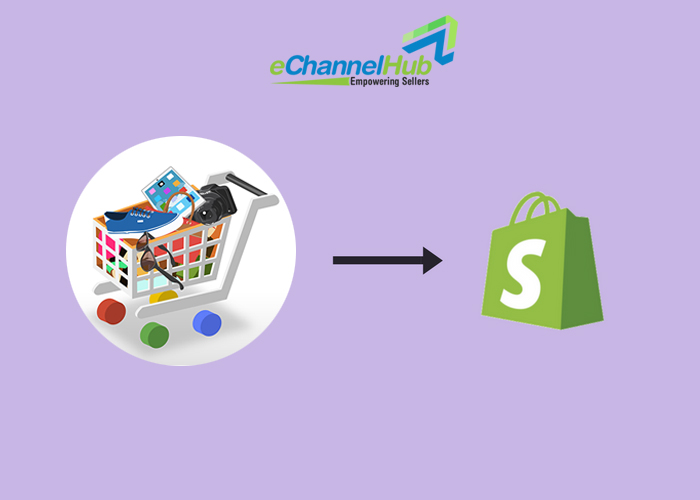First-Time Shopify Product Importers – One Answer To Five Common Problems

Setting up your Shopify store, and using multichannel listing tool for Shopify to list your sale items across multiple channels could be exciting. Yet, if you are a merchant trying to import products from leading marketplaces such as eBay, Amazon etc. to your Shopify store for the first time, the task may seem overwhelming. From facing certain hurdles to wasting a lot of time, you may feel stuck and going nowhere while importing your product to the Shopify store. But before we address the common problems merchants face, it’s important to analyze the problems. This way, instead of finding a random solution, which may or may not help later on, we can understand the root cause of the problem and find a solution best suited for it. And that’s exactly what eChannelHub’s Shopify integrations do to give Shopify merchants a solitary yet effective solution to their five common problems.
What the figures tell
Before looking deeper into the problems faced by first-time Shopify product importers, eChannelHub took a closer look at how popular Shopify is. According to the company’s second quarter 2018 financials, its total revenue stood at $245 million, which was an impressive 62% increase over its comparable quarter in 2017. Its Subscription Solutions revenue increased by 55% to touch the $110.7 million mark, which was driven primarily by growth in MRR (Monthly Recurring Revenue). This growth in MRR was primarily fueled by an increase in the number of merchants who joined the Shopify platform. Shopify’s MRR as of June 30, 2018 stood at $35.3 million. This was an increase of 49% compared to its MRR as of June 30, 2017, which was $23.7 million. Despite its steady and continuous growth in MRR with every passing year, the problems Shopify merchants face while importing their products is spread across the world, which makes it a pressing issue that should be addressed fast and effectively.
An analysis by eChannelHub found the most pressing problems that first-time Shopify product importers face to be the following:
- Importing bulk groups of product data
Shopify gives you the ability to import CSV files, which is great when you sell just on Shopify. But when you sell on sell on multiple marketplaces like eBay, Amazon, Etsy etc; have to handle messy and large product catalogs; receive product catalogs from several suppliers, which you need to modify before putting them up for sale on your web store; and want to change your product information from your ERP/POS system to make it ready for your online store, creating a CSV file containing all the updated, modified and properly formatted product information means doing a lot of legwork on your part. Since you don’t want to plan on editing and changing your product list after importing, working on the CSV files to import your products in bulk into Shopify becomes an extremely daunting task.
- Store development
Setting up an online store isn’t just about listing an array of products. You need to ensure products in your store are easy to find for potential customers, the navigation is easy to browse multiple products, the traffic your store is getting gets converted into sales, and above all, your store is set up in such a way that it makes your customers trust you and feel safe while buying from your store. But first-time product importers on Shopify often feel puzzled as to how they can create a customer-friendly web store and improve their shop’s online visibility. Most merchants aiming to sell across multiple platforms think that it’s just about using a multichannel listing tool for Shopify to list their products and import the ones they need from other marketplaces to set up a Shopify store.
- Product Authorization
First-time Shopify Importers often don’t have adequate knowledge of product management. Combined with their lack of experience, they often face problems while setting up authorization of their products for sale. For example, if you have some specific products that have gone out of stock, you can still sell them as pre-orders. However, you will need to create an alternate product template in addition to editing your payment settings. In case you have some products that are on back-order, you may even use this customization to carry on selling them. But Shopify members importing products for the first time often neither have the knowledge nor the experience of how they should handle such product authorizations.
- Inventory management
For Shopify sellers, both underselling and overselling can be nightmares. While selling a product that has run out of stock reflects badly on your reputation and credibility, having a product in stock that isn’t listed and thus not selling is equally a big headache for a merchant. Yet, proper maintenance of inventory levels is a domain where many first-time Shopify importers often falter. As a seller, you need to build a loyal customer base that will buy from you, praise your products, and even recommend their friends and family to buy from you. For this to happen, you customers should have a fair idea of what’s in your stock, what’s no longer available for sale, and products that are soon coming up for sale. Displaying incorrect inventory is simply something that you can’t afford to do as it will drive your customers away, and erode the relationships and reputation you have so painstakingly build until that point of time.
- Attracting customers
Once they have imported their products, many first-time Shopify importers simply wait for their customers to find them. And when that doesn’t happen, they get worried about how they can find them to sell their products. Since these merchants are new to the Shopify store, they often don’t know about the simple steps that can improve their web store’s traffic and boost conversions. Something as simple as submitting their sitemap to Google to improve their Shopify store’s visibility, using targeted keywords to improve SEO, setting up an About Us and Contact page, linking their social media accounts to their store, creating and managing ad campaigns on Instagram and Facebook etc. could have helped them set the ball rolling.
What’s the solution?
To take these common problems out of the life of first-time Shopify importers, eChannelHub brings Shopify integrations with leading marketplaces like Amazon, eBay, Etsy, Walmart and more. With our Shopify integrations, you can benefit a lot as first-time Shopify importers as they let you
- Import bulk lists of products in just a few clicks along with all variations such as price, images, SKUs, inventory, etc.
- Use real-time inventory sync tool to enjoy auto-syncing of price and inventory from multiple marketplaces to your Shopify store.
- Enjoy seamless syncing of newly added products on other marketplaces to your Shopify store.
- Convert currency based on what suits your customers the best, which is especially helpful if you sell the same products worldwide across different regions in their local currencies.
- Design a search-engine friendly and customer-centric store with better online visibility and seamless navigation to offer your customers an improved shopping experience.
- Get support for multiple warehouses, which would make it easy for you to upload products and set your inventory to a specific warehouse depending on the selected product.
How eChannelHub’s integrations would make a difference in your life as a first-time Shopify importer?
Our Shopify integrations basically address your common pain-points and let you get complete control on your inventory to grow your sales. From our inventory management system software that lets you track your inventory to our real-time inventory sync tool that syncs your inventory with your Shopify store, our integrations make inventory updates faster with just a few clicks, enables faster processing of orders, and even helps you ensure faster stock replenishment by choosing a warehouse of your choice for particular products. All these aspects can help you to strengthen and expand your business even when you are a first-time Shopify importer. To get started on your journey of becoming a successful Shopify store owner, get expert help right away by reaching out to eChannelHub today!
Write For Us
Gain multichannel inventory visibility and control with eChannelHub
Learn more about eChannelHub with a free demo, tailored for your unique retail business.
Request A DemoRequest a Demo
Gain multichannel inventory visibility and control with eChannelHub
Learn more about eChannelHub with a free demo, tailored for your unique online business




